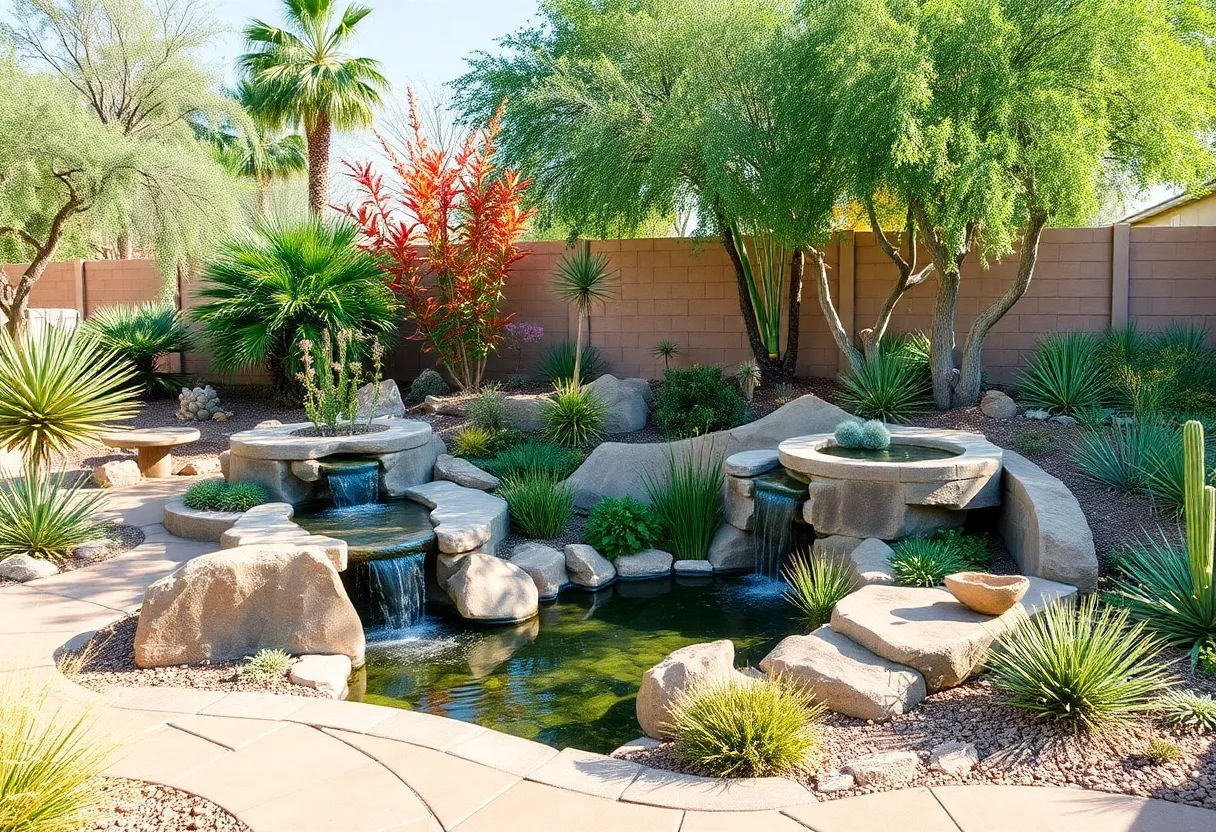How to Design a Desert Oasis Garden in Your Phoenix Backyard
Introduction
Crafting a desert oasis garden in your Phoenix backyard offers a tranquil retreat perfectly adapted to the region’s unique climate. By carefully selecting drought-tolerant plants, integrating hardscaping elements, and employing strategic water management, you can develop a sustainable, visually compelling outdoor space. Such gardens serve not only as aesthetic enhancements but also as functional refuges that conserve water and reduce maintenance demands specific to desert environments.
Understanding the Phoenix Climate
Phoenix’s climate is typified by intense summer heat and mild, pleasant winters. Annual rainfall averages around 8 inches, making water conservation essential. The high temperatures—often exceeding 100°F in summer—necessitate plants that can endure extreme heat without significant irrigation. With low humidity and high evaporation rates, implementing strategies that minimize water waste and maximize soil retention is imperative.
Design Principles for a Desert Oasis Garden
1. Incorporate Native and Drought-Tolerant Plants
Utilize plant species adapted to arid climates. Native selections ensure resilience and low water needs. Key options include:
- Agave: Features dramatic rosettes, minimal watering, and long lifespan.
- Yucca: Tall, architectural spikes with sword-like leaves enhance vertical interest.
- Cacti: Variants like saguaro and barrel cacti create distinctive shapes and textures.
- Succulents: Plants such as aloe and jade store water efficiently, thriving with little irrigation.
2. Implement Xeriscaping Techniques
Xeriscaping minimizes water use through strategic design. Core techniques include:
- Soil Preparation: Amend soil with organic matter like compost to boost water retention capacity.
- Mulching: Organic mulches such as bark or gravel help conserve moisture, suppress weeds, and regulate soil temperature.
- Irrigation Systems: Use drip irrigation for precise water delivery directly to plant roots, reducing runoff and evaporation.
3. Utilize Hardscaping Elements
Incorporating durable, low-maintenance surfaces enhances aesthetics and functionality:
- Gravel Pathways: Decomposed granite or river rock define movement within the garden without water requirements.
- Boulders and Rock Formations: Strategically positioned boulders add natural appeal and help stabilize soil on slopes.
- Pavers: Permeable concrete or stone pavers facilitate water infiltration and create attractive patios or seating areas.
4. Create Shade and Shelter
Providing shade mitigates the harsh desert sun and extends usability:
- Pergolas: Wooden or metal structures can be draped with shade fabrics or native vines.
- Ramada: Traditional open-sided shelters offer cooling comfort and visual interest.
- Shade Trees: Plant palo verde or mesquite, which are native and tolerant of local conditions, to create natural shaded areas.
5. Incorporate Water Features
Even in arid landscapes, water features add aesthetic tranquility and ecological benefits:
- Fountains: Solar-powered options with minimal water usage generate soothing sounds.
- Ponds: Edged with native aquatic plants, ponds attract local wildlife and provide cooling effects.
- Rainwater Harvesting: Systems that collect and store rainwater supplement irrigation, promoting sustainability.
6. Add Lighting and Art Installations
Thoughtful lighting and art elevate nighttime ambiance and personalize your oasis:
- String Lights: Use bistro or fairy lights over seating zones for soft illumination.
- Sculptures: Desert-themed sculptures or natural stone art add visual focal points.
- Mosaics: Incorporate colorful tile mosaics into pathways or walls to showcase craftsmanship and color.
Maintenance Considerations
For longevity and ongoing visual appeal, maintenance must be balanced with sustainability:
- Pruning: Remove dead or overgrown branches, especially from xeriscape plants to maintain shape and health.
- Weeding: Regular removal of invasive or opportunistic weeds prevents competition for resources.
- Irrigation Checks: Routine inspections of drip lines and valves ensure efficient water distribution.
Conclusion
Designing a desert oasis garden in your Phoenix backyard hinges on a strategic approach rooted in local climate awareness and sustainable practices. Prioritizing native plants, conserving water with xeriscaping, and employing durable materials helps craft a space that is both beautiful and eco-friendly. Such gardens transform narrow backyards into serene retreats, blending functionality with natural desert aesthetics. When executed thoughtfully, your oasis will serve as a resilient, low-maintenance haven for relaxation and enjoyment year-round.
Frequently Asked Questions
What are the best native plants for a desert oasis in Phoenix?
Native plants such as palo verde, mesquite, agave, yucca, and various cacti are ideal for resilience, low water consumption, and blending with the native landscape.
How does xeriscaping benefit a desert garden?
Xeriscaping reduces water use by designing landscapes with drought-tolerant plants, efficient irrigation, soil amendments, and mulching, making the garden sustainable and low-maintenance.
What water features are suitable for a desert garden?
Small, low-water fountains, ponds with native aquatic plants, and rainwater harvesting systems are suitable options that enhance tranquility while conserving water.
How can I provide shade in my Phoenix backyard?
Install pergolas, ramadas, and plant native shade trees like palo verde or mesquite to create shaded areas, reducing heat exposure and increasing usability.
Key Features of a Desert Oasis Garden
| Feature | Details | Benefits |
|---|---|---|
| Native Plants | Agave, yucca, cacti, mesquite, palo verde | Resilient, low water, native aesthetics |
| Xeriscaping | Soil amendments, mulching, drip irrigation | Water efficient, low maintenance |
| Hardscaping Elements | Gravel paths, boulders, permeable pavers | Structural interest, erosion control |
| Shade Structures | Pergolas, ramadas, shade trees | Protection from sun, extended outdoor use |
| Water Features | Fountains, ponds, rain harvesting | Tranquility, wildlife attraction |
| Lighting & Art | String lights, sculptures, mosaics | Ambiance, visual interest |
Author: STAFF HERE PHOENIX WRITER
The PHOENIX STAFF WRITER represents the experienced team at HEREPhoenix.com, your go-to source for actionable local news and information in Phoenix, Maricopa County, and beyond. Specializing in "news you can use," we cover essential topics like product reviews for personal and business needs, local business directories, politics, real estate trends, neighborhood insights, and state news affecting the area—with deep expertise drawn from years of dedicated reporting and strong community input, including local press releases and business updates. We deliver top reporting on high-value events such as the Waste Management Phoenix Open, Cactus League Spring Training, and Arizona State Fair. Our coverage extends to key organizations like the Greater Phoenix Chamber of Commerce and Visit Phoenix, plus leading businesses in technology and healthcare that power the local economy such as Intel and Banner Health. As part of the broader HERE network, including HERETucson.com, we provide comprehensive, credible insights into Arizona's dynamic landscape.





